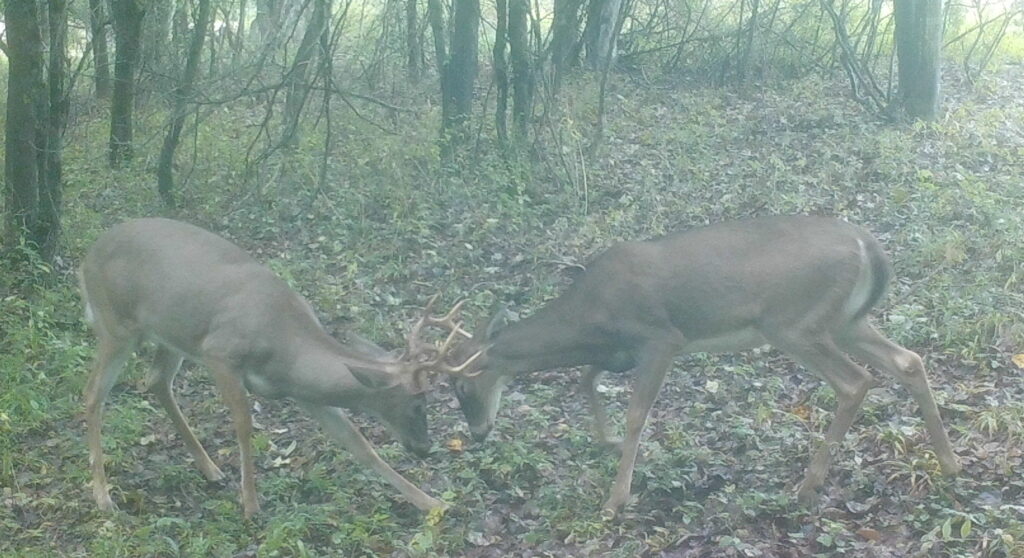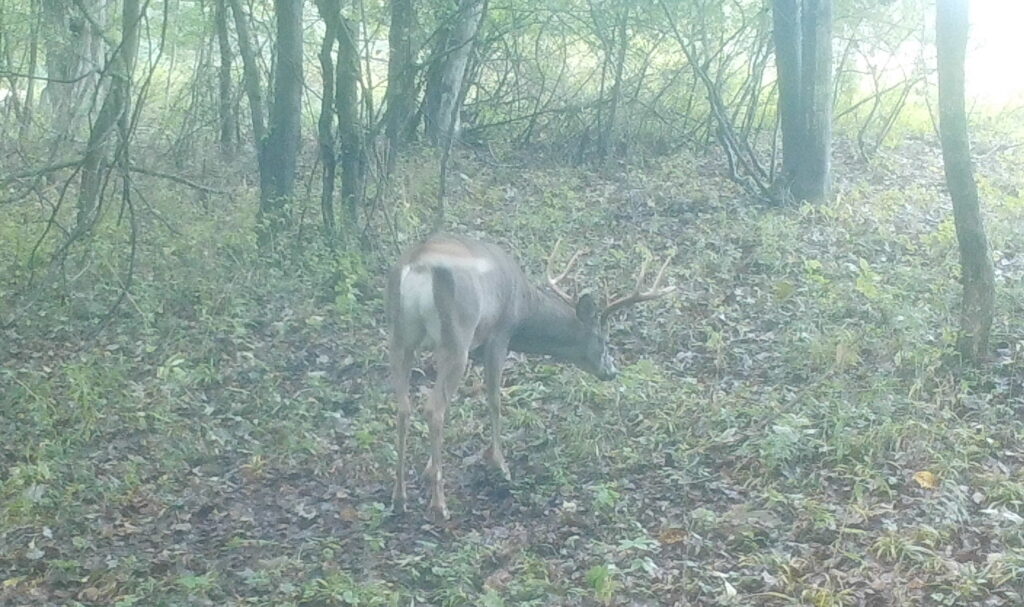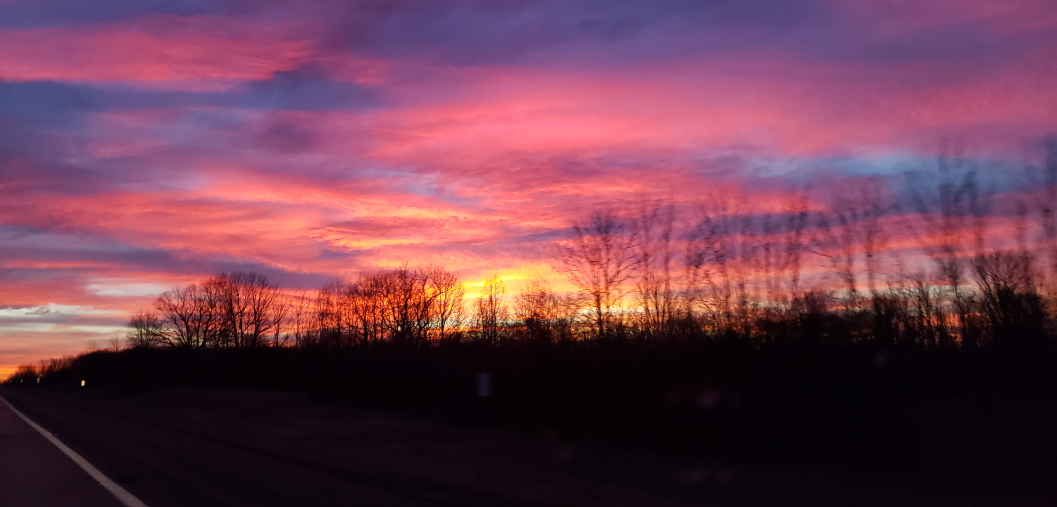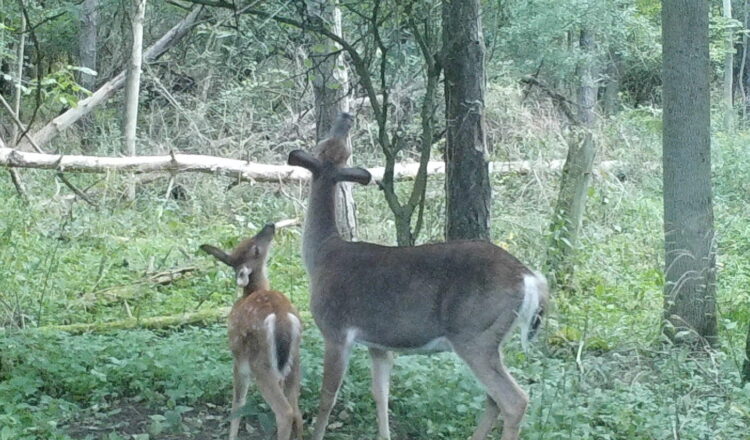“Think of it as bio-chemical atomized emails and text messages”
By Oak Duke, image: Doe shows a fawn how to mark a “licking branch”
Trail cameras, set up on whitetail scrapes, at locations in the woods where deer deposit breeding pheromones, has given us overwhelming digital evidence that mature does have as much to do with “managing” or setting the stage of the rut as do bucks.

In the past, our excitement upon seeing a hot scrape showed us what we wanted to see in our imagination…a big mature buck was there!
We are just spectators to the world of the whitetail as they communicate in the subtlest ways with their scent posts and sign-marking, by their creations of rubs, scrapes on the ground, and the all-important licking, or overhanging branch.
Deer and other critters, what scientists term “short-day breeders” like sheep can not mate at any random time of the year, as do many other species of mammals including man.
Whitetails need to synchronize their bio-chemical systems with each other. And they do it through complex patterns of receiving and exuding pheromones. Think of it as bio-chemical atomized emails and text messages.
Whitetails have an Internet, but it is an olfactory, scent-based Internet communication system.
When bucks and does scent-check a scrape, it is just like the way we communicate now on social media or with our phones but through scent.
Scientists now know that each whitetail has its own micro-biome, as does each person.
A micro-biome is an individual’s scent trail of bacteria, microbes, and pheromones along with resultant gases and molecular reactions that spill out of our bodies.
As some of us who deer hunt do to the extreme, and other people do as a matter of personal hygiene, we all try to be as scent-free as possible.
But our best efforts are swimming against the current.
The process of living creates continual floods and plumes of microbes, bacteria and their interactions as we walk, sit, and breathe.
Same with whitetails, only deer read these micro-biome emissions with much greater sensitivity and reaction than we do.
At these woodland scrape sites with the all-important overhanging branch, mature does leave their calling cards to prime the timing of the rut as do bucks, creating a macro-biome at what we call the community scrape.
Bucks may or may not initiate the scrape, though this statement goes against what hunters have been taught down through the years.
Many scrapes begin as licking branches, and are expanded and become the more visually obvious “ground pad” when hit, or scent-marked and dug up by rutting bucks.

Traditional hunting lore has always emphasized the notion that signpost marking was primarily, if not exclusively a buck thing. And we thought the track in the ground scrape must be a buck. But modern technology (trail cams) has shown us that the track in the mud under the licking branch is actually as likely to be a doe as a buck.

Researchers have been able to prove that our individual structure of microbes and pheromones become similar in time with other individuals as we interact.
Humans, like whitetails and other critters, trade bacteria and our own unique entourage of microbes, bacteria, and constant plumes of pheromone gases.
But what are the primary vehicles for these most important whitetail micro-biome emissions?
Glands, urine, or something else?
The whitetail hunting scent industry with its varying degrees of effectiveness and marketing, has focused primarily on what is termed estrus scents, and most are urine-based.
This focus on reproductive glands and their secretions are, after all, logical because glandular secretions are obvious and easily marketable.
But when does and bucks visit a scrape with an overhanging branch, most of the time they do one thing…they mouth or lick the overhanging branch.

And sure, once in a while, they urinate or defecate there, sometimes apparently on purpose. But they most always mouth the overhanging branch.
Why deer scent companies do not focus more on whitetail saliva, as the primary scent at the scrape is beyond me!
A few years back when I noticed the preponderance of digital camera evidence showing bucks and does at scrape sites mouthing and licking the overhanging limb, I decided to test my premise that the whitetail’s saliva, especially the mature doe’s is a major scent trigger at the scrape site.
So I swabbed out the mouth of doe I had harvested during the peak of the rut with cotton swabs and put them out at scrape sites. (I used cotton swabs because they were easy to store in the freezer and convenient to transport, scent free, in a zip-lock bag.)
Doe saliva as a major transport vehicle for pheromone communication was immediate and at the least, anecdotally conclusive.
The vast majority of visits to these doctored scrapes with saliva-soaked cotton balls, by whitetail bucks, showed them depositing saliva there, with a much greater frequency and obvious excitement than any other fluid.
And with further tests and experiments, down through the subsequent years, there has been little reason for modification of the conclusion that saliva from does, primes the rut’s timing at least as much as any buck, mature or otherwise.
Oak Duke/Wellsville, NY/September 2023
Contact Oak anytime, to talk about whitetail deer or buy honey!! Did you know that Duke is an accomplished beekeeper?
Whitetail Page: www.facebook.com/Oak.Duke.whitetail.page
Duke’s Honey: www.facebook.com/Dukes-Honey-513590015445371/






